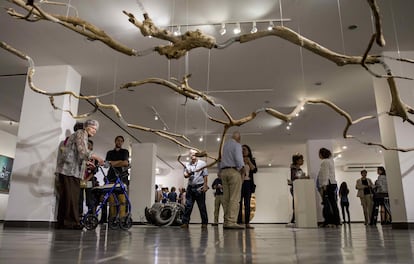The Nicaraguan artist Patricia Belli (Managua, 60 years old) claims that she has managed to “sublimate” her wounds, turning them into art, in a creative process that she has defined as “a recovery experience.” Belli has explored the scars of fear, memory and concerns generated by economic problems, migration and violence in a region, Central America, in permanent tension. This artistic commitment to its environment has been recognized this Wednesday with the Velázquez Prize, corresponding to 2025, an award worth 100,000 euros. “I am very grateful, super honored,” says Belli in a telephone interview. “It’s unexpected. I always do my work with a lot of sportsmanship, the best I can, but I don’t expect anything. And this is like a bomb, but a very happy bomb,” the artist reacts.
The jury highlighted “the impact of his work in the Latin American context, specifically in Central America, and his commitment to education in a context of fragility.” Likewise, he considers that “his work on the memory of vulnerable bodies, the scar left by fear and shame, as well as his cultural activism, are a reference for various generations of artists.” “His work involves the sensoriality of the public to propose reflections linked to subjectivity, trauma, imbalance and power mechanisms,” notes the note from the Ministry of Culture after granting his prize. “The union of opposites is a transversal axis in his work, in which he reflects on issues such as oppressor-oppressed, pleasure-pain and nature-civilization. On the other hand, he pays special attention to the collective unconscious, from which he obtains symbolic references.”
Belli is one of the most influential plastic artists in Central America. His work, which moves between installation, photography, video and performance, explores the tensions between the body, vulnerability, memory and social structure, always from a critical and deeply personal perspective. “I see memory not as a living wound, but as a scar from what I have experienced. When I discovered that I was making scars, which was when I started working with used clothes, tearing them and suturing them, I saw that there was a common thread that had to do precisely with the wound that was not only healed by nature, but mended. In other words, there is a hand that heals, a healing will. I felt that I had found something that gave me relief, that made me feel like I could breathe better,” he explains.
Belli comes from a family of artists. His early childhood memories, he has said, are marked by the creative influence of his parents: his father painting and taking photographs; and mother making clothes and other crafts, experimenting with her hands. After graduating in Visual Arts in 1986 from Loyola University in New Orleans (Louisiana) and in 1997 in Arts and Letters from the Central American University (UCA) in Managua, Belli obtained a Master of Visual Arts in sculpture at the San Francisco Art Institute in 2001.
The award jury has also highlighted his commitment to art teaching. Belli founded EspIRA, an organization for the sensitive and critical training of artists, which has been key in the emergence of new generations of creators in the region. Through workshops, residencies and support programs, the creator has promoted a critical and autonomous artistic scene in contexts of great institutional fragility. “I feel very honored that this was one of the criteria for my selection. I have been working with young artists for many years. And I feel very lucky to say that many of these artists are now also dedicated to teaching,” she says. In a region where there is a lack of resources and little support for art from the authorities, Belli has managed to create a strong community of artists. Recently, an exhibition called domestic territorywhich brought together 23 artists who emerged from the academic project she founded. “It was a great joy to see how professional artists they are,” he says.
The Nicaraguan participated in Mesotica II (1996-1997), Politics of difference (2001-2002) y doubtful strait (2006), three exhibitions of historical relevance for the process of visibility of Central American art in those years. She was also invited to the Biennials of Havana (1989 and 2000), Central America and the Caribbean (Domingo Santo, 1994 and 2001), Lima (1997), Cuenca (2011), Ireland (2018), Berlin (2018) and FEMSA, Mexico (2020-21) and to the 58th Carnegie International (2022), as well as to various editions of the Biennial Nicaraguan and Central American. An anthological exhibition of her work toured San José, Managua and Guatemala City between 2016 and 2017. “I believe that symbolic reality is fundamental to learning to live and coexist. Undoubtedly. Art is part of that symbolic reality,” says the artist.
In recent editions, the winners of the Velázquez Prize for Plastic Arts have been Francesc Torres (2024), Marisa González (2023), the Argentine Elda Cerrato (2022), the Cuban Tania Bruguera (2021) and Soledad Sevilla (2020).

